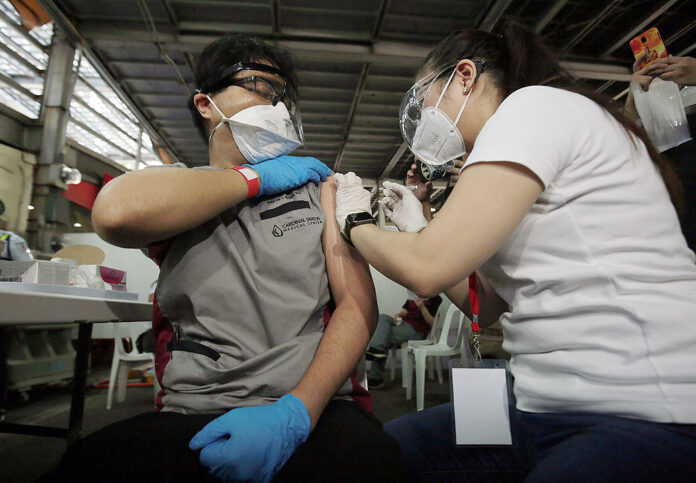The Philippines’ coronavirus task force has tasked health authorities to determine the COVID-19 alert level classifications of all areas in the country, according to the presidential palace.
The Department of Health (DoH) will coordinate with a group managing coronavirus data to determine the risk status of an area, Cabinet Secretary Karlo Alexei B. Nograles said at a regular news conference.
The recommendation will be approved and announced by the pandemic task force, he said.
The final alert level classifications cannot be appealed, Mr. Nograles noted.
Recommendations for new alert level classifications “will be given in time for the 15th and the end of the month,” he said. “However, assessment of areas will be done weekly to determine areas requiring immediate escalation.”
The Palace official said authorities may escalate alert level classifications at any time within the implementation period if warranted, noting that de-escalations would only be done at the end of the implementation period.
He reminded the public to always follow health protocols. “We have already seen what can happen when we become lax.”
At the same briefing, Mr. Nograles said establishments, both public and private, can reject people who refuse to wear face masks.
Under the enforcement of the alert level system first tested in the Philippine capital and nearby areas, establishments are directed to ensure the implementation of health protocols and to “exclude all persons who cannot comply with the same from their respective premises.”
“In other words, a person who does not follow the rule on wearing a face mask may not be allowed entry in an establishment,” he said in Filipino.
FEWER COVID CASES
Citizens being urged to continue following health rules to sustain the current decline in the number of coronavirus cases.
Philippine health authorities on Thursday reported the lowest number of active coronavirus cases this year at 17,796.
The country has also been imposing stricter rules on unvaccinated people, as more businesses around the world have been prioritizing fully vaccinated job seekers and patrons.
The government will require employees doing on-site work in high-risk areas to be fully vaccinated starting next month. This will be enforced in areas with a stable supply of vaccines, according to the presidential palace.
Critics have said hiring based on an applicant’s vaccination status is highly discriminatory. Requiring people to get vaccinated may also lead to political divisions and tarnish the credibility of the government’s pandemic response, they added.
The Philippines has declared Nov. 29, Nov. 30, and Dec. 1 as national COVID-19 vaccination days, with the aim of inoculating at least 15 million Filipinos.
Private and public workers who will participate in the vaccination drive would not be considered absent from their work as long as they present proof of vaccination to their employers.
An analysis of hospital data from March 1 to Nov. 14 showed that 85% of admissions due to COVID-19 are not fully vaccinated, Health Undersecretary Maria Rosario S. Vergeire said in a statement.
“Moreover, deaths and serious outcomes are more likely to happen among unvaccinated patients, with over 93.4% of them dying based on the reports gathered by DoH,” she added.
“Protecting our health through vaccination will increase our confidence to go out and see our loved ones this Christmas, as well as ensure a safe return to work,” she said. “So we encourage every eligible individual, especially our lolo and lola, and our loved ones who have underlying medical conditions who are not yet vaccinated, to take advantage of these National Vaccination Days and get your jabs done.”
A poll conducted by the Social Weather Stations from Sept. 27 to 30 found that 64% of adult Filipinos were now willing to get vaccinated against the coronavirus, up from 55% in June.
COVID BY THE NUMBERS
The Philippines has relaxed pandemic rules after it contained a spike in infections that exhausted hospitals.
Health authorities reported 863 new coronavirus cases on Friday, bringing the total number of cases to 2.83 million since the start of the pandemic.
The death toll hit 48,017 after 142 more patients died, while recoveries increased by 791 to 2.76 million, the DoH said in a bulletin.
The agency said there were 17,853 active cases, 51.5% of which were mild, 21.57% were moderate, 14.2% were severe, 6.6% were asymptomatic, and 6.1% were critical.
It said 29% of intensive care units nationwide were occupied. The rate for Metro Manila was also 29%.
The Health department said 17 duplicates had been removed from the tally, 16 of which were recoveries, while 128 recoveries were relisted as deaths. It added that 77 cases “were found to have tested negative and have been removed from the total case count.” Two laboratories failed to submit data on Nov. 24. — Kyle Aristophere Atienza

